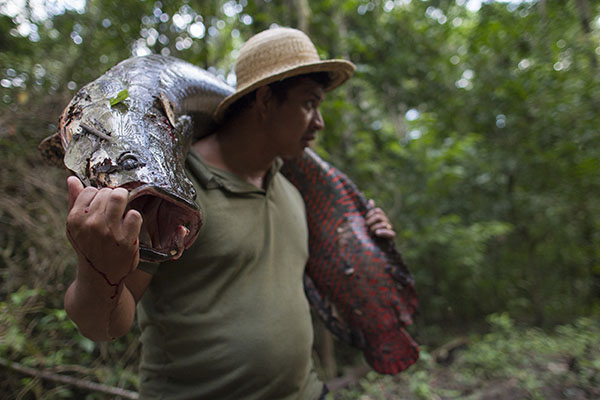The Amazon's Largest Fish is Being Fished into Extinction
| Nikki Alfonso | | Aug 14, 2014 01:44 AM EDT |
(Photo : Reuters) Amazon's arapaima
The numbers of arapaima, the Amazon River's largest fish, is quickly dwindling and can no longer be found in some areas of the Amazon basin.
In fact, the fish, commonly known as piracuru, is known for its ability to breathe in air. The ability to breathe air is both a blessing and a curse for the arapaima.
Like Us on Facebook
Breathing air allows it to survive oxygen-poor water environments, but also makes it easier to catch. Arapaima spawning on the edge of floodplain forests gulp in air every 5 to 15 minutes, allowing local fishermen to find and harpoon them.
Weighing more than 400 pounds and measuring up to 10 feet, arapaima is a sought-after local food source. Local fishermen continue to fish for it even in areas with very low arapaima populations.
With some communities realizing the depletion of this food source, many fishermen have decided to "fish-down," meaning to catch smaller fish. This method, however, continues to be detrimental to the arapaima's existence.
Instead of using harpoons, fishermen use nets to catch smaller fish. In the process, they also catch young arapaima fish.
Despite the grim reality of fishing-down and overfishing, researchers have discovered that in areas where arapaima fishing is regulated, the giant fish is thriving. This gives scientists hope that by protecting the arapaima, the species might once regain its ecological foothold.
"The time has come to apply fishers' ecological knowledge to assess populations, document practices and trends, and solve fisheries problems through user participation in management and conservation," said Leandro Castella, lead scientist of the study and assistant professor of fisheries at Virginia Tech's College of Natural Resources and Environment.
An interesting and peculiar feature of the arapaima is its primitive lung that allows it to breathe air on the surface. Its gills allow it to breathe underwater.
The fish developed this unusual ability because it typically lives in waterways that don't have much oxygen.
©2015 Chinatopix All rights reserved. Do not reproduce without permission
EDITOR'S PICKS
-

Did the Trump administration just announce plans for a trade war with ‘hostile’ China and Russia?
-

US Senate passes Taiwan travel bill slammed by China
-

As Yan Sihong’s family grieves, here are other Chinese students who went missing abroad. Some have never been found
-

Beijing blasts Western critics who ‘smear China’ with the term sharp power
-

China Envoy Seeks to Defuse Tensions With U.S. as a Trade War Brews
-

Singapore's Deputy PM Provides Bitcoin Vote of Confidence Amid China's Blanket Bans
-

China warns investors over risks in overseas virtual currency trading
-

Chinese government most trustworthy: survey
-

Kashima Antlers On Course For Back-To-Back Titles
MOST POPULAR
LATEST NEWS
Zhou Yongkang: China's Former Security Chief Sentenced to Life in Prison

China's former Chief of the Ministry of Public Security, Zhou Yongkang, has been given a life sentence after he was found guilty of abusing his office, bribery and deliberately ... Full Article
TRENDING STORY

China Pork Prices Expected to Stabilize As The Supplies Recover

Elephone P9000 Smartphone is now on Sale on Amazon India

There's a Big Chance Cliffhangers Won't Still Be Resolved When Grey's Anatomy Season 13 Returns

Supreme Court Ruled on Samsung vs Apple Dispute for Patent Infringement

Microsoft Surface Pro 5 Rumors and Release Date: What is the Latest?










